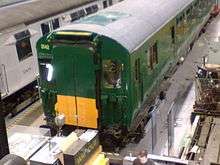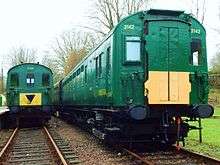British Rail Class 404
| Southern Railway 4-COR, 4-BUF, 4-RES, 4-GRI British Rail Class 404 | |
|---|---|
|
| |
| In service | 1937–1972 |
| Manufacturer | SR Lancing Works (underframes), Eastleigh Works (bodywork) |
| Constructed | 1937-38 |
| Formation | Power car + 2 trailer cars + power car |
| Operator(s) |
Southern Railway, British Railways |
| Specifications | |
| Train length | 265 ft 2 in (80.82 m) |
| Width | 9 ft 8 1⁄2 in (2.96 m) |
| Maximum speed | 75 mph (121 km/h) |
| Weight | 158 long tons 5 cwt (354,500 lb or 160.8 t) |
| Traction motors |
Four MV163 Metropolitan Vickers (later English Electric EE163) |
| Power output |
4 x 225 hp (168 kW) total 900 hp (671 kW) |
| Electric system(s) | 600 - 750 V DC third rail |
| Current collection method | Contact shoe |
| UIC classification | Bo′2′+2′2′+2′2′+2′Bo′ |
| Braking system(s) | Automatic Air |
| Coupling system | Screw-link |
| Multiple working | Standard SR system |
| Track gauge | 4 ft 8 1⁄2 in (1,435 mm) standard gauge |
The Southern Railway (SR) gave the designations 4-COR, 4-RES, 4-BUF and 4-GRI to the different types of electric multiple unit built to work the route between London Waterloo and Portsmouth Harbour. The 4-COR type units survived long enough in British Rail ownership to be allocated TOPS Class 404. The COR designation had previously been used for the 6-PUL units and was reused by them during World War II when the Pullman car was stored, but this stock was different from the 4-COR units.
Phase 1 units
The SR electrified the London Waterloo to Portsmouth Harbour via Woking line in the mid-1930s, and full electric services commenced over the route from April 1937. For this service, 29 4-COR units (4-car Corridor units, numbered 3101–3129) and 19 4-RES units (4-car Restaurant units, numbered 3054–3072) were built.
Corridor connections were provided throughout each unit, including between units. This gave them a distinctive front-end appearance as the headcode display was placed on the opposite side of the gangway connection to the driving cab window, leading to their nickname of Nelsons (referring to Lord Nelson's eyepatch, and also to their connection with Portsmouth).
It was intended that, for principal services, 12-car formations would operate with a 4-RES unit (providing the kitchen and dining facilities for the train) sandwiched by two 4-COR units. While all the other carriages for these units were built by the SR at its Eastleigh Works, the Trailer First carriages (which were laid out as dining cars) were built by the Birmingham Railway Carriage and Wagon Company (BRCW) and the Trailer Restaurant Kitchen Third carriages by Metropolitan Cammell.
Phase 2 units
The SR then electrified the line from Three Bridges to Portsmouth via Horsham and the coastal route from West Worthing to Havant, with services over this route commencing in July 1938. For services from London Victoria to Portsmouth via Dorking over these lines, another 26 4-COR units (numbered 3130–3155) were built, together with 13 4-BUF units (4-car Buffet units, numbered 3073–3085).
These new units followed the same design as the Phase 1 stock, except that the restaurant and kitchen facilities of the 4-RES units were replaced by the simpler provision of a buffet. All of these units were built by the SR at its Eastleigh works.
Formations
Initial formations of these units were as follows:
| Units | Type | DMBTO | Trailer | Trailer | DMBTO |
|---|---|---|---|---|---|
| 3054-3072 | 4-RES | 11139–11175 (odds) | TFK 12232–12250 (not in order) | TRKT 12601–12619 (not in order) | 11140–11176 (evens) |
| 3073–3085 | 4-BUF | 11229–11253 (odds) | TCK 11846–11858 | TRBT 12518–12530 | 11230–11254 (evens) |
| 3101–3129 | 4-COR | 11081–11137 (odds) | TTK 10055–10083 | TCK 11791–11819 | 11082–11138 (evens) |
| 3130–3155 | 4-COR | 11177–11227 (odds) | TTK 10084–10109 | TCK 11820–11845 | 11178–11228 (evens) |
Reformations and conversions
Due to the late delivery of the kitchen and dining carriages for the 4-RES units, these cars were not formed in the sets in numerical order, and some of the driving motor cars initially ran with other trailer cars as 4-COR formations.
The first changes took place during World War II, following the destruction of 25 carriages during bombing raids. This total included the equivalent of three 4-RES units. A number of units were reformed to re-use the carriages that survived from individual units, and after the war was over new carriages were built to replace those destroyed, taking the numbers of the old ones. In total this involved eleven driving motor cars, seven Trailer Thirds, five Trailer Composites, and one buffet car and dining car apiece. This re-arrangement led to the loss of 4-RES units 3058, 3060 and 3063 and the formation of three new 4-COR units, which took numbers 3156–3158.
In 1955 4-RES unit 3072 was converted to a 4-BUF unit following a fire in the kitchen car, which was rebuilt as a prototype Restaurant Buffet design for British Rail. In 1961–1962 the kitchen cars in 4-RES units 3056, 3065 and 3068 were converted into Griddle cars. The units involved were given the classification 4-GRI, and in 1964 they were renumbered 3086–3088.
In January 1964 the remaining 4-RES units were disbanded and the carriages reformed with former 6-PUL and 6-PAN stock. Between then and the final withdrawal of these carriages at the end of the 1960s a variety of different unit formations were created, including further 4-COR units (numbers 3159–3166), 6-COR (3041–3050), 4-PUL (3054–3059), 4-COR(N) (3065–3071) and 6-TC (601). For further details of this complex period of unit reformations, see here.
Accidents and incidents
- On 3 June 1960, an empty stock train formed by two units of the class overran signals at Waterloo and was in a sidelong collision with a steam-hauled passenger train that was departing for Weymouth, Dorset. A few passengers suffered slight injuries.[1]
Withdrawal and further use
Apart from the 4-RES units, which were disbanded in 1964, the 4-COR, 4-BUF and 4-GRI types continued in existence through to the withdrawal of this stock from passenger service in 1972. Thereafter the underframes of a number of carriages were reused by the engineering department as long welded rail carriers and crane runners. A full list of vehicles affected is below:
| Old Number | New Number | Old Number | New Number | Old Number | New Number | ||
|---|---|---|---|---|---|---|---|
| 10081 | DB975519 | 11847 | DB975520 | 11846 | DB975521 | ||
| 11849 | DB975522 | 11856 | DB975523 | 11817 | DB975524 | ||
| 11854 | DB975525 | 10064 | DB975526 | 11800 | DB975527 | ||
| 12245 | DB975528 | 10079 | DB975529 | 11815 | DB975530 | ||
| 11802 | DB975531 | 10103 | DB975532 | 12235 | DS70281 | ||
Preservation

One complete unit was saved for preservation, as were a number of individual vehicles. The complete 4-COR(N) 3142 was purchased by the Southern Electric Group for preservation by British Rail in 1972 and moved to the since defunct Steam Centre at Ashford (Kent).
In 1976 it was moved north to the Nene Valley Railway and helped form the opening train in 1977. The unit came south again to Brighton in September 1986 for restoration work. The unit was moved again to St Leonards Engineering Depot in 1991 as better facilities aided restoration. By 2003 the unit had to be moved to the Bluebell Railway, with S11187S going to London Transport Museum at Acton.
Later on three of the unit's coaches were moved to the East Kent Railway, with one coach remaining at Horsted Keynes station as an exhibit coach. In late 2012 S11187S was moved to join the three more coaches at the East Kent Railway. The unit has been operational as a two coach hauled unit since July 2013; the Southern Electric Group continues further restoration work on the unit to date.

Details are set out of surviving vehicles below:
| Unit No. | Type | DMBTO | TTK | Trailer | DMBTO | Livery | Owner | Notes |
|---|---|---|---|---|---|---|---|---|
| - | 4-RES | - | - | 12235 | - | - | Eden Valley Railway | Underframe Only [2] |
| 3131 | 4-COR | 11179 | - | - | - | BR Green | National Railway Museum | - |
| 3135 | 4-COR | 11187 | - | - | - | SR Green | Southern Electric Group | - |
| 3142 | 4-COR | 11161 | 10096 | TCK 11825 | 11201 | SR Green | Southern Electric Group | 11161 ex-4Res unit 3065. |
References
- ↑ Moody, G. T. (1979) [1957]. Southern Electric 1909-1979 (Fifth ed.). Shepperton: Ian Allan Ltd. p. 147. ISBN 0 7110 0924 4.
- ↑ http://www.cs.vintagecarriagestrust.org/se/CarriageInfo.asp?Ref=4276
- Source
- Marsden, Colin J. (1983). Southern Electric Multiple-Units 1898–1948. Shepperton, Surrey: Ian Allan Limited. pp. 48–58. ISBN 0-7110-1253-9.
External links
| Wikimedia Commons has media related to British Rail Class 404. |
- Southern Electric Group - Owners of Set no. 3142.
- Southern Electric Group - Details of class designation.
- History of the 4 COR units on www.BloodandCustard.com